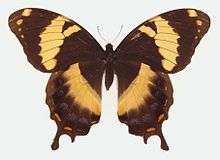Papilio homerus
| Homerus swallowtail | |
|---|---|
 | |
| Scientific classification | |
| Kingdom: | Animalia |
| Phylum: | Arthropoda |
| Class: | Insecta |
| Order: | Lepidoptera |
| Family: | Papilionidae |
| Genus: | Papilio |
| Species: | P. homerus |
| Binomial name | |
| Papilio homerus Fabricius, 1793 | |
Papilio homerus, the Homerus swallowtail or Jamaican giant swallowtail, is the largest swallowtail butterfly in the Western Hemisphere and the largest species in the genus Papilio[2] with an average wingspan of about 15 centimetres (5.9 in)[3] (the African giant swallowtail has a larger wingspan, but this is mainly due to its elongated forewings). The Homerus swallowtail belongs to the swallowtail family (tribe: Papilionini) and is often placed in the subgenus Pterourus, considered a full genus by some authors.
It is found only in forests in Jamaica and is under significant pressure from habitat loss and potentially also from collecting.[4] It has also been shown that death rates due to parasitic wasps of the genus Chrysonotomyia are higher in disturbed habitats.[5] The Homerus swallowtail was relatively common in the 1930s[6] and its range used to be contiguous,[5] but it has now retracted to a main population in the Blue and John Crow Mountains in eastern Jamaica, and a tiny population, estimated at less than 50 adults, in Cockpit Country in the west of the island.[2] It is listed as endangered by the IUCN[1] and is included on Appendix I of CITES,[7] thereby making international trade illegal. In addition to better protection of the remaining populations and their habitat, it has been suggested that a captive breeding program may help save the species.[2] The caterpillars feed exclusively on Hernandia jamaicensis and H. catalpifolia; both of which also are endemic to Jamaica.[5]
Taxonomy
Papilio homerus is the nominate member of the homerus species group. The members of this clade are:
- Papilio cacicus Lucas, 1852
- Papilio euterpinus Salvin & Godman, 1868
- Papilio garamas (Geyer, [1829])
- Papilio homerus Fabricius, 1793
- Papilio menatius (Hübner, [1819])
- Papilio warscewiczii Hopffer, 1865
Papilio homerus is in the subgenus Pterourus Scopoli, 1777 which also includes the species groups: troilus species group, glaucus species group, the zagreus species group and the scamander species group.
Ecozone
It lives in the Neotropical ecozone.
Etymology
In common with other early entomologists Fabricius followed the classical tradition. The name honours the Greek poet Homer.
References
- 1 2 Gimenez Dixon, M. (1996). "Papilio homerus". IUCN Red List of Threatened Species. Version 2008. International Union for Conservation of Nature. Retrieved 30 July 2010.
- 1 2 3 Lehnert, M. S. (2008). The population biology and ecology of the Homerus swallowtail, Papilio (Pterourus) homerus, in the Cockpit Country, Jamaica. Journal of Insect Conservation 12(2): 179-188
- ↑ The National Environment and Planning Agency. Jamaica's Protected Species. Downloaded on 30 July 2010.
- ↑ ScienceDaily (2007). Largest Butterfly In Western Hemisphere Needs Help To Avoid Extinction. Downloaded on 30 July 2010.
- 1 2 3 Garraway, E., A. J. A. Bailey, B. E. Freeman, J. R. Parnell and T. C. Emmel (2008). Population studies and conservation of Jamaica’s endangered swallowtail butterfly Papilio ( Pterourus ) homerus. Journal of Insect Conservation 12 (3-4): 383-397
- ↑ Florida Museum of Natural History. Research Projects - Conservation. Downloaded on 30 July 2010.
- ↑ CITES (2011). Appendices I, II and III. Version 27 April 2011.
- Collins, N. Mark; Morris, Michael G. (1985). Threatened Swallowtail Butterflies of the World: The IUCN Red Data Book. Gland & Cambridge: IUCN. ISBN 978-2-88032-603-6.
- Emmel, T. C., and E. Garraway. 1990. Ecology and conservation biology of the Homerus Swallowtail in Jamaica (Lepidoptera: Papilionidae). Tropical Lepidoptera 1(2): 63-76.pdf Abstract: The Homerus Swallowtail, Papilio homerus Fabricius (Lepidoptera: Papilionidae), once inhabited seven of the thirteen parishes on the island of Jamaica. Today, it is found only in two isolated and diminishing strongholds: an eastern population in the parishes of St. Thomas and Portland, and the western population in the rugged Cockpit Country of Trelawny and St. Elizabeth. The ecology of the remaining populations is described, including habitat characteristics, seasonally, altitudinal range, host plants, behavior and other associated biological information. A summary of the stages of life history is illustrated by color photographs. The principal threats to the continued existence of the species are (1) destruction of the virgin wet rain forest habitat, and (2) commercial collecting in the remaining small populations. The establishment of patrolled nature reserves or a national park is recommended for the remaining habitat areas, as well as a possible butterfly farming program to lessen pressures on small wild populations.
- Garraway, E., and J. R. Parnell. 1993. Notes on the osmeteria of Papilio homerus larvae (Lepidoptera: Papilionidae). Tropical Lepidoptera 4(1): 29-30. pdf Abstract: All larval instars of Papilio homerus have well developed osmeteria. Close up photography of living larvae shows the osmeteria are light pink in the first three instars and brick red in the fourth and fifth instars. Notes on the reluctance of mature larvae to extrude the osmeteria and protective camouflage are included.
- Turner, T.W., 1983). The status of the Papilionidae, Lepidoptera of Jamaica with evidence to support the need for conservation of Papilio homerus Fabricius and Eurylides marcellinus Doubleday. Unpublished report. 14 pp.
- Lewis, H. L., 1974 Butterflies of the World ISBN 0-245-52097-X Page 25, figure 3 (female).

